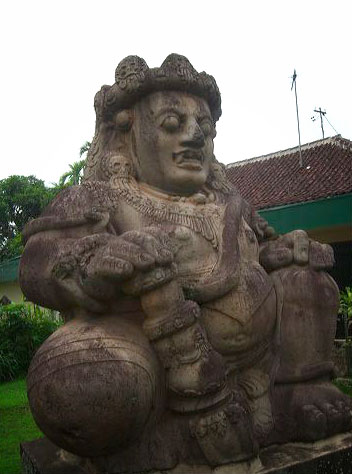Singosari

Numerous temple remains dating from the 13th century kingdom of Singosari can still be seen in the Malang region. Well known sites include Candi Singosari, Jajaghu (or Jago), Kidal, as well as the so called 'Bathing Place of Ken Dedes'. All are to be found within a thirty kilometre radius from the city of Malang.
The dynasty of Singosari was established in A.D. 1222, when the young ruler of Tumapel, Ken Angrok, defeated the last king of Kediri. Legend has it that Ken Angrok was born from the union of his mother and the god Brahma. Abandoned in a cemetery shortly after his birth, the infant was subsequently adopted by a thief, who taught the child all the tricks of his trade.
Ken Angrok grew up to become a notorious gambler, running up debts to the point where both his mother and stepfather were forced into slavery. He then took to thievery himself and ended up in so much trouble that on several occasions Brahma had to intervene when he feared for the boy's life.
Ken Angrok's fortune changed when he learned that it was his destiny to become king of Java. Captivated by the young queen of Tumapel, named Ken Dedes, he sought a way to win her by murdering her husband. This, however, was no easy task and required the forging of a special keris (Javanese double edged sword), endowed with supernatural power.
The weapon was eventually completed, but not without a price. In anger and impatience at having to wait so long for the keris, Ken Angrok ended up stabbing the unfortunate metal smith who, as he lay dying, cursed the murderer and his descendants, swearing that they would all die by the same weapon which Ken Angrok now held in his hand. The curse was not long in taking effect and the rest of the century saw a bitter and bloody family feud. Shortly after Ken Angrok took the throne and married Ken Dedes, he was betrayed by his wife and died at the hand of his stepson, Anusapati, who ruled Singosari for twenty years.
Yet, despite excessive precautions such as having a moat built around his bed, Anusapati too fell victim to the keris maker's curse, stabbed while contesting in a cock fight. His memorial shrine is at Candl Kidal. Anusapati's successor was Wisnuwardhana, during whose reign the beautiful temple of Jajaghu was built. Following him came Kertanagara, the last and most famous king of Singosari. It was the time of the Mongol expansion in Asia, when a descendant of Genghiz Khan ruled in China. Demanding tribute from all the rulers in south east Asia, the Khan sent an envoy to the court of Kertanagara.
The bold Javanese king sent his reply back to China, carved into the forehead of the emperor's delegate. Before the enraged Khan was able to organize a retaliatory fleet, however, Kertanagara was ambushed by soldiers from a neighbouring vassal state and put to death alongside a number of his priests and ministers.
The two shrines dedicated to Kertanagara are CandiSingosari and Candi Jawi. The former is located in the village of Singosari, which is thought to have been the centre of the old kingdom, on the outskirts of Malang; Candi Jawi can be found at Pandaan, to the south of Surabaya in the foothills of the Arjuna/Welirang mountain range. The dynasty of Singosari came to a close with the death of Kertanagara in 1292. This king is considered by Javanese to have been the first to envisage a united Indonesia, a dream which was to become reality some fifty years later under the leadership of Gajah Mada.









